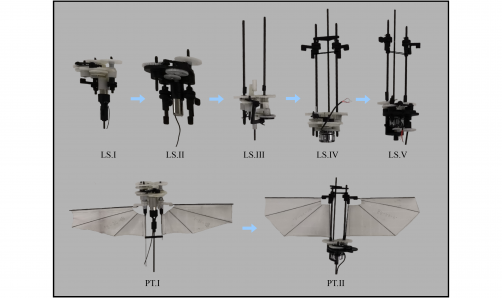Top Stories
Researchers Unveil Breakthrough Lift System for Flapping Wing Drones

URGENT UPDATE: A groundbreaking study has just been released, revolutionizing the design of flapping wing micro air vehicles (FWMAVs). Researchers from Beihang University and Tsinghua University have developed a novel lift system capable of achieving remarkable aerodynamic performance while drastically reducing power consumption.
The research, titled “Lift System Optimization for Hover-Capable Flapping Wing Micro Air Vehicle,” addresses the longstanding challenges in FWMAV technology. Current models, whether motor-driven or utilizing intelligent materials, have struggled with flight control and efficiency. This new study introduces an innovative approach that mimics the natural mechanics of hummingbirds, enabling unprecedented maneuverability.
Key to this advancement is the integration of elastic energy storage elements at the wing root, effectively simulating the musculoskeletal system of hummingbirds. The prototype features a flapping angle of 154° and incorporates a crank-rocker mechanism combined with a gear system to enhance lift capabilities.
Initial tests demonstrate that this optimized wing, designated as “80-455,” utilizes advanced materials like Icarex PC31 and boasts a wingspan of 80 mm, a chord length of 45 mm, and a 5° slack angle. These elements collectively enhance lift generation, achieving a remarkable stable lift of 31.98 g with a total weight of only 10.5 g.
Additionally, the fuselage’s weight has been reduced by 30.4%, dropping from 2.3 g to 1.6 g, without compromising structural integrity or introducing resonance issues. This lightweight design is critical for improving overall flight efficiency.
The findings, published in July 2023, reveal that the FWMAV can hover for approximately 1 minute at 50% throttle and perform complex maneuvers, showcasing its potential for various applications, from environmental monitoring to search and rescue operations.
As the research progresses, the team, led by Shengjie Xiao, Yongqi Shi, Zemin Wang, and others, aims to refine the technology further. The implications of this study are vast, potentially paving the way for a new generation of drones that are more efficient, agile, and responsive.
The full text of the study is available for review at https://doi.org/10.1007/s11465-024-0790-6. This breakthrough could reshape the future of aerial robotics and inspire new innovations in the field. Stay tuned for further updates as this story develops.
-

 Business4 days ago
Business4 days agoInvestors Eye Potential $60,000 Gains with Ozak AI Token
-

 Business5 days ago
Business5 days agoQuotient Wealth Partners Adjusts Holdings in iShares Russell 1000 ETF
-

 Politics5 days ago
Politics5 days agoFormer Pastor Arrested on Human Trafficking and Indecent Charges
-

 Politics4 days ago
Politics4 days agoSkip Bayless Critiques Travis Hunter’s Game Day Baptism
-

 Entertainment6 days ago
Entertainment6 days agoUtah Residents Face Resource Shortages Amid Ongoing Government Shutdown
-

 Business6 days ago
Business6 days agoCalifornia to Ban All Plastic Bags in Grocery Stores by 2026
-

 Lifestyle5 days ago
Lifestyle5 days agoNatty from KISS OF LIFE Stuns in Micro-Shorts at Seoul Event
-

 Science5 days ago
Science5 days agoCommunity Mourns Loss of Judith Ernst, Pioneer Educator at 81
-

 Entertainment6 days ago
Entertainment6 days agoEastside Kings Festival Celebrates Austin’s Rich Blues and Jazz Heritage
-

 Entertainment5 days ago
Entertainment5 days agoPete Davidson Surprises Pregnant Girlfriend with Private Jet to Concert
-

 Entertainment5 days ago
Entertainment5 days agoAce Frehley, KISS Guitarist, Passes Away at 74 After Fall
-

 Politics5 days ago
Politics5 days agoIberia Parish Sees Surge in Marriage Licenses Issued in October









